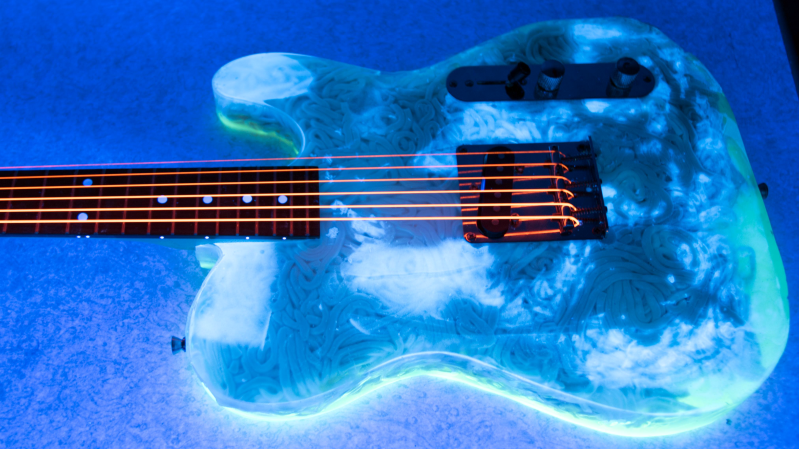Wood. Specifically, certain types of tone woods; woods that impart a certain tone. That’s what guitars are made of. And occasionally, plastic, or metal, or fibreglass or, well, anything. [_forwardaudio_] built his out of noodles, because, why not?
Well, not completely out of noodles. Epoxy is used to give some strength to the noodles, because, despite the fantastic tone that noodles impart to the guitar, they’re not known for their strength. The epoxy helps keep the noodles in place, focusing their noodly tone.
To add a bit of punch to the look of the guitar, the back and front of the body have UV powder blended in, blue on the front and green on the back. Once the guitar was assembled, a set of UV strings were added as well, to add even more glowy goodness.
In the video (after the break) the build process is shown along with the simplified, volume only, wiring. At the end, [_forwardaudio_] noodles around on the guitar a bit.
I’ll show myself out.
If noodles aren’t your thing, maybe you’d prefer 3D printing an extended fretboard for your guitar, or to build yourself a 12 foot long guitar.
Via Reddit.
















He sounds to me like Kurt Harland from Information Society.
Do the noodles go… bad? Change color? What’s the guitar look like in a year or two? Bad Noodles sound like the name of an album.
I don’t think anything will happen to the Noodles if it is stored in a relatively dry environment most of the time.
Why would the environment t’s stored in matter? Here’s an experiment to try: put some wet noodles in a plastic bag and leave it sit on a shelf for a week or two then tell me what happens to it.
The noodles weren’t sterile going into the epoxy, there was no special handling that would keep them sterile even if they started that way. A few bacterial cysts or fungal spores from the air, a tiny bit of organic material, a tiny bit of water are all it takes.
Ooooh spolted noodles…
I don’t think it’s wise to embed organic materials like noodles in epoxy. The noodles are going to rot, and the gas released will crack the body of the guitar.
I was thinking the same thing, as he did not appear to dessicate or treat the noodles first.
On a more practical note, perhaps wooden shavings, such as those used in evaporative (swamp) cooler mats, or even just plain old toothpicks, might have been a better choice.
Oh yeah, it’s going to stink bad, too!
Organic’s not a problem, Peter Brown embeds all kind of stuff in epoxy. However the fact that the noodles were wet might be a problem.
Agreed. If they were dried noodles, they’d probably last close to forever. But he combined organic material, moisture and you can see air bubbles throughout, with probably larger voids of air in the center where the epoxy couldn’t flow into. This thing is going to start rotting from within, no doubt. I once made a little snow globe type scene of a wooden boat (sealed with resin) floating in some water sealed in a light bulb. Mold started to grow inside within 2 weeks.
But I suspect noodles were probably perfect for the desired effect of this video – racking up views. There’s a larger audience for zomg! A guitar made from noodles, that’s so AWESOME!!! type views than there is for a more practical build.
Epoxy curing is an exothermic reaction. It might generate high enough temperature to kill bacteria.
Not even close.
Initially I thought it was the Guitar strings that were made from noodles.
Then it reminds me of this video:
https://www.scmp.com/video/china/3012482/chinese-man-uses-instant-noodles-repair-broken-things
https://www.ulc.org/assets/ulc/blog/scaled/flyingspaghetti.jpg
Church approved.
Arrrrrrr this is approved.
Its been pretty much debunked that the wood has little if any effect on the “tone” of an electric guitar. Unplugged sound? yes, but from the pickups, no.
Hmmm. Why do different body styles with similar pick ups sound different then?
Different masses and thus different resonant frequencies?
Wouldn’t that be the wood “making a difference” then?
Different pickups in different positions and different strings maybe?
Different positions would entail that the wood does modify the sound.
I’ve built a few about 15 years ago, and the Kahler bridge definitely changed its sustain characteristics when we tried mahogany, ash, and maple.
I wasn’t referring to the pickup position in the wood affecting it. I was suggesting that picking up the field from the strings at different positions along the string would change the sound. That’s why guitars with multiple pickups can produce different sound by selectively blending the outputs from the pickups that are placed at two (or more) locations along the strings.
In the guitars you built, was the only thing that changed the type of wood, or did you use different pickups at different positions in the guitars?